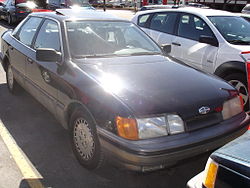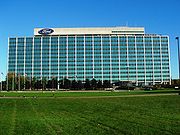- Merkur Scorpio
-
Merkur Scorpio 
Manufacturer Ford Motor Company Production 1988-1989 Assembly Cologne, Germany[1] Class Executive car Body style 5-door hatchback Layout FR layout Engine 2.9 L Cologne V6 Wheelbase 108.7 in (2,761 mm)[2] Length 186.4 in (4,735 mm) Width 69.5 in (1,765 mm) Height 54.6 in (1,387 mm) Related Ford Granada
Ford Sierra
Merkur XR4TiThe Merkur Scorpio is a modified European Ford Scorpio with 4 doors and lift gate (hatch) which was manufactured and sold as 1988 and 1989 models. It was unsuccessful in the American market, which contemporary observers attributed to poor marketing.[3]
Contents
Inspiration
The Merkur Scorpio, along with the Merkur XR4Ti, was developed from two of Ford's European executive cars: the Ford Scorpio Mark I and the Ford Sierra, respectively. They were manufactured in Germany and sold in North America as captive imports.
The XR4Ti only came as a 2 door vehicle with liftgate, and the Scorpio only came as a 4 door with a lift gate. Unlike the popularity the European Fords enjoyed, both the Merkur Scorpio and the XR4Ti fell prey to several different issues that led to Merkur name being discontinued in North America.
Production Figures 1989[4] Year Units 1989 8,765 Appearance
Like many vehicles of the 1980s, the Merkur Scorpio has a similar design to Volvos, Mercedes-Benz, Honda Accord and also has similarities with Mercury Sable, but has more of a sporty appearance.
The Merkur logo is featured on the front as a flush mounted hood ornament, and also on the standard alloy wheels and steering wheel. The rear left side says "Scorpio" and the right side says "Merkur", leading a few to believe that have seen the car for the first time thinking it is called "Scorpio Merkur". Some restored vehicles might have the make and model signs incorrectly reversed. The antenna is also flush mounted beside the rear window. The top half of the car is one color and the bottom half is another color. The main grille opening is narrow with a plastic border. Sometimes this border falls off causing the radiator fan to become easily visible.
The instrument panel includes a speedometer that reads up to 150 miles per hour and 240 kilometers per hour. Canadian model Scorpios have speedometers that have this reversed, making kilometers per hour the primary speedometer reading. It has a tachometer on the left side of the speedometer, and on the right side is a fuel gauge and engine temperature gauge. Beside that is a door ajar alert that is drawn as an aerial view of the car.
To the right side of the steering wheel is a digital automatic climate control system. There are several digital readings throughout the dash board. One is indoor temperature and climate control setting. Another is the radio station frequency. Near the rear view mirror is a clock, timer, compass, and outdoor temperature. The cars also feature large trunks with similar "Sto-N-Go" back seats. This connects the back seat passenger section with the trunk for additional cargo storage. The rear seats also have the seat belt connections attached to the backrest instead of between the two seat sections, making them impossible to get "lost".
Since most Merkur Scorpios have moon roofs, there are two dome lights and a set of map lights—one for the front seat and one for the rear seat. Interior colors are usually tan or black.
Performance
With a modern suspension designed originally to be competitive in a tough European marketplace, the Merkur Scorpio handled decently according to press accounts at the time of its launch. Unfortunately, the combination of a basic design that was middle of the pack in Europe, a slightly softer retuning for US road conditions and preferences and, finally, all season tires left the Scorpio an inferior performer compared to similarly sized and priced European products, such as Saabs and Volvos.
The 2.9 L Cologne V6 offered reasonable performance for the period from its 144 horsepower, but again, when compared to other vehicles in its class, such as the 185 hp Saab 9000, the product was merely average.
Prices
Original suggested retail prices for "standard" features is $24,048.00 with $3,015 in options. Since most vehicles include the all options including Automatic Transmission (some estimate figures at less than 60 North American Scorpios came equipped with a T-9 5 speed manual transmission, similar to the one installed in the XR4Ti), the prices were usually $27,063.00 and up. They were sold at Lincoln-Mercury Dealerships as they were performance executive sporty luxury cars that were imported.
Discontinuation
The Merkur Scorpio was expensive to many customers, and was also confusing to some for how to maintain them. There were small electrical problems (the locks locking and unlocking by themselves for example). Importing the vehicles was expensive, and several other problems resulted in the failure to be recognized as a high quality affordable luxury performance vehicle. Additional failure for the Merkur line to be successful was also caused by not introducing the same line of Sierra Cosworth, which remain very popular and sought after to this day.
Parts
Most of the parts for Merkur Scorpios are widely available. Certain custom features are not, however. There are still some available but some parts have to be found in Europe and shipped internationally. Some people purchase used Merkur Scorpios, both functional or having minor or major problems only to have them completely scrapped for parts to be sold.
The Scorpio used a high security design called a Tibbe key in the ignition; this design is still used on European Fords and most Jaguar cars, but they are relatively uncommon in the US. There are few unused blank keys for replacements in the states, and most have to be sourced from Ford of Europe.
See also
- Merkur
- Ford Scorpio (Europe) and Ford Granada (Mk III in UK)
External links
References
Merkur road car timeline, 1985-1989 1980s 5 6 7 8 9 Compact XR4Ti Mid-size Scorpio Categories:- Merkur vehicles
- Cars of the United States
- Hatchbacks
- 1980s automobiles
Wikimedia Foundation. 2010.

